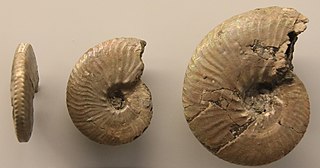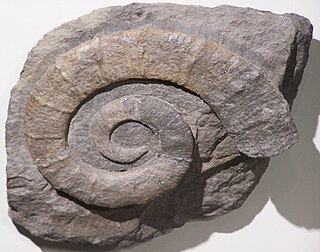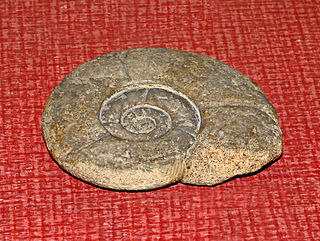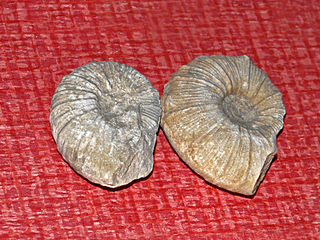In the geologic timescale, the Bajocian is an age and stage in the Middle Jurassic. It lasted from approximately 170.3 Ma to around 168.3 Ma. The Bajocian Age succeeds the Aalenian Age and precedes the Bathonian Age.
The Hauterivian is, in the geologic timescale, an age in the Early Cretaceous Epoch or a stage in the Lower Cretaceous Series. It spans the time between 132.9 ± 2 Ma and 129.4 ± 1.5 Ma. The Hauterivian is preceded by the Valanginian and succeeded by the Barremian.
Kamerunoceras is an extinct cephalopod genus belonging to the ammonite family Acanthoceratidae, found in Upper Cretaceous formations of Africa, Europe and North and South America.

Ancyloceras is an extinct genus of heteromorph ammonites found throughout the world during the Lower Cretaceous, from the Lower Barremian epoch until the genus extinction during the Lower Aptian.

Anahoplites is a genus of rather involute, compressed hoplitid ammonites with flat sides, narrow flat or grooved venters, and flexious ribs or striae arising from weak umbilicle tubercles that end in fine dense ventrolateral nodes. The elements of their sutures are short, wide and jaggedy. Specimens of Annahoplites have diameters typically in the range of 4–6 centimetres (1.6–2.4 in) although some with diameters of as much as 19 centimetres (7.5 in) have been reported. The genus lived during the Cretaceous, from the Middle to the late Albian.
Balearites is an extinct ancyloceratin genus included in the family Crioceratitidae, subclass Ammonoidea, from the Upper Hauterivian.

Crioceratites is an ammonite genus from the Early Cretaceous belonging to the Ancyloceratoidea.
Bochianites is a straight shelled ammonite which lived from the Upper Jurassic, Tithonian, to the Lower Cretaceous, Hauterivian in what is now Europe, Greenland, Africa, North America and Asia. The shell is long, narrow, moderately expanding; smooth or with weak to strong oblique annular ribs. Sutural elements are short and boxy. The umbilical lobe, which lies between the lateral lobe and dorsal lobe, on either side, is about the same size as the lobule dividing the first lateral saddle.

Ancyloceratidae is a family of heteromorphic ammonites that lived during the Early Cretaceous. Their shells begin as a loose spiral with whorls not touching which then turns into a straight shaft that ends in a J-shape hook or bend at end. Coarse ribbing and spines are common.

Puzosia is a genus of desmoceratid ammonites, and the type genus for the Puzosiinae, which lived during the middle part of the Cretaceous, from early Aptian to Maastrichtian. Sepkoski defines the range from Albian to Santonian. The generic name comes from the Serbian words "Puž" (snail) and "oce/ose" (axis), gaining its name from the shell's snail-like appearance.

Spitidiscus is a genus of ammonites placed in the family Holcodiscidae.

Phyllopachyceras is an extinct genus of ammonoid cephalopods belonging to the family Phylloceratidae. These nektonic carnivores lived in the Cretaceous, from Hauterivian to Maastrichtian to age.

Crioceratitidae is an extinct cephalopod family belonging to the subclass Ammonoidea and included in the order Ammonitida.

Holcodiscus is an ammonite genus placed in the family Holcodiscidae. Species in this genus were fast-moving nektonic carnivores. The type species of the genus is Ammonites caillaudianus.

Dufrenoyia is an extinct genus of Cretaceous ammonites included in the family Parahoplitidae. These fast-moving nektonic carnivores lived in the Cretaceous period. The type species of the genus is Ammonites dufrenoyi.

Sonneratia is an extinct genus of Cretaceous ammonites included in the family Hoplitidae. These fast-moving nektonic carnivores lived in the Cretaceous period, Aptian - Albian age.

Lyelliceras is a genus of ammonites belonging to the family Lyelliceratidae. These cephalopods were fast-moving nektonic carnivores. They lived in the Cretaceous period, Albian stage.

Ostlingoceras is an extinct genus of ammonites belonging to the Turrilitidae family.

Eotetragonites is an extinct genus of ammonite.

Juraphyllites is a genus of ammonites belonging to the family Juraphyllitidae.















